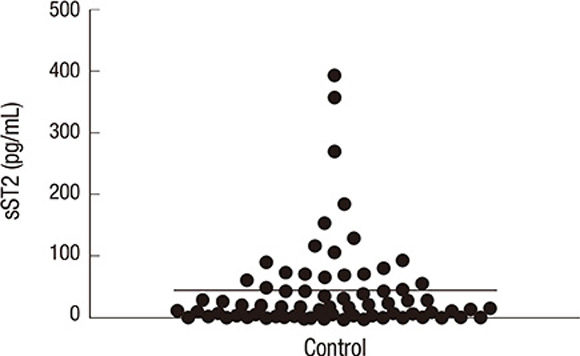To the Editor:
Dear Editor,
I would like to give my comments on recently published article titled 'Serum Level of Interleukin-33 and Soluble ST2 and Their Association with Disease Activity in Patients with Behcet's Disease.' In this article authors had looked for sST2 in serum and found its level in pico-gram range (23.56 ± 3.25 pg/mL and 99.01 ± 15.92 pg/mL in control and disease patients respectively), however, previous published report indicates the level of sST2 in nano-gram range (1-3). Since, sST2 represents a promising biomarker in different diseases, it is necessary to clarify this discrepancy.
I would really appreciate if you can provide your valuable comments in this regard.
Dr Rohit Saluja
References
1. Lu J, Snider JV, Grenache DG. Establishment of reference intervals for soluble ST2 from a United States population. Clin Chim Acta. 2010; 411:1825–1826.
2. Tang S, Huang H, Hu F, Zhou W, Guo J, Jiang H, Mu R, Li Z. Increased IL-33 in synovial fluid and paired serum is associated with disease activity and autoantibodies in rheumatoid arthritis. Clin Dev Immunol. 2013; 2013:985301.
3. Zhang K, Zhang XC, Mi YH, Liu J. Predicting value of serum soluble ST2 and interleukin-33 for risk stratification and prognosis in patients with acute myocardial infarction. Chin Med J (Engl). 2013; 126:3628–3631.
The Author Response:
Dear Dr Rohit Saluja
We would like to thank Dr Saluja for the helpful comments regarding our publication in J Korean Med Sci (1), and we appreciate the opportunity to reply. In the article, serum levels of IL-33 and sST2 were measured in the 53 patients with Bechet's disease (BD) and 31 normal controls (NC). Serum levels of sST2 were higher in patients with BD compared with those in NC: sST2, 99.01 ± 15.92 pg/mL in BD and 23.56 ± 3.25 pg/mL in NC (P < 0.001) (1). In order to measure the serum levels of sST2 in the article, we used human ST2/IL-1R4 Duoset ELISA Development kit (RnDsystems, Catalog Number DY523).
Dr Saluja indicated that serum levels of sST2 from normal controls are too low, proposing the reference value shown in Quantikine Human ST2/IL-1 R4 Immunoassay (RnDsystems, Catalog Number DST200). Therefore, we remeasured serum levels of sST2 in 72 normal controls once again. The mean levels of sST2 from the 72 normal controls are 44.80 ± 8.71 pg/mL) (below Figure). Data are expressed as mean ± SEM. We abided by the manufacturer's protocol including the concentrations of capture antibodies and detection antibodies, reaction time, temperature, etc.

Dr Saluja proposed Quantikine Human ST2/IL-1 R4 Immunoassay (R&D Systems, Catalog Number DST200) in which a monoclonal antibody specific for human ST2 has been pre-coated onto a microplate. However, we coated capture antibodies overnight ourselves and performed all other processes following the manufacturer's protocol (used human ST2/IL1R4 Duoset ELISA Development kit, R&D Systems, Catalog Number DY523). The differences between two ELISA kits might partially explain the discordant results.
Recently, Zhao et al. (2) demonstrated the role of IL-33 in patients with primary Sjogren's syndrome. They measured serum levels of sST2 in 78 normal controls and the means levels were 60.3 pg/mL. These findings are quite similar to our results.
Currently, we do not explain the exact reason. One important thing is that serum levels of sST2 were significantly higher in patients with BD than in normal controls. Thank you once again for helpful comments concerning the article.
References
1. Kim DJ, Baek SY, Park MK, Park KS, Lee JH, Park SH, Kim HY, Kwok SK. Serum Level of Interleukin-33 and Soluble ST2 and Their Association with Disease Activity in Patients with Behcet's Disease. J Korean Med Sci. 2013; 28:1145–1153.
2. Zhao L, Yao L, Yuan L, Xia L, Shen H, Lu J. Potential contribution of interleukin-33 to the development of interstitial lung disease in patients with primary Sjogren's Syndrome. Cytokine. 2013; 64:22–24.




 PDF
PDF ePub
ePub Citation
Citation Print
Print


 XML Download
XML Download